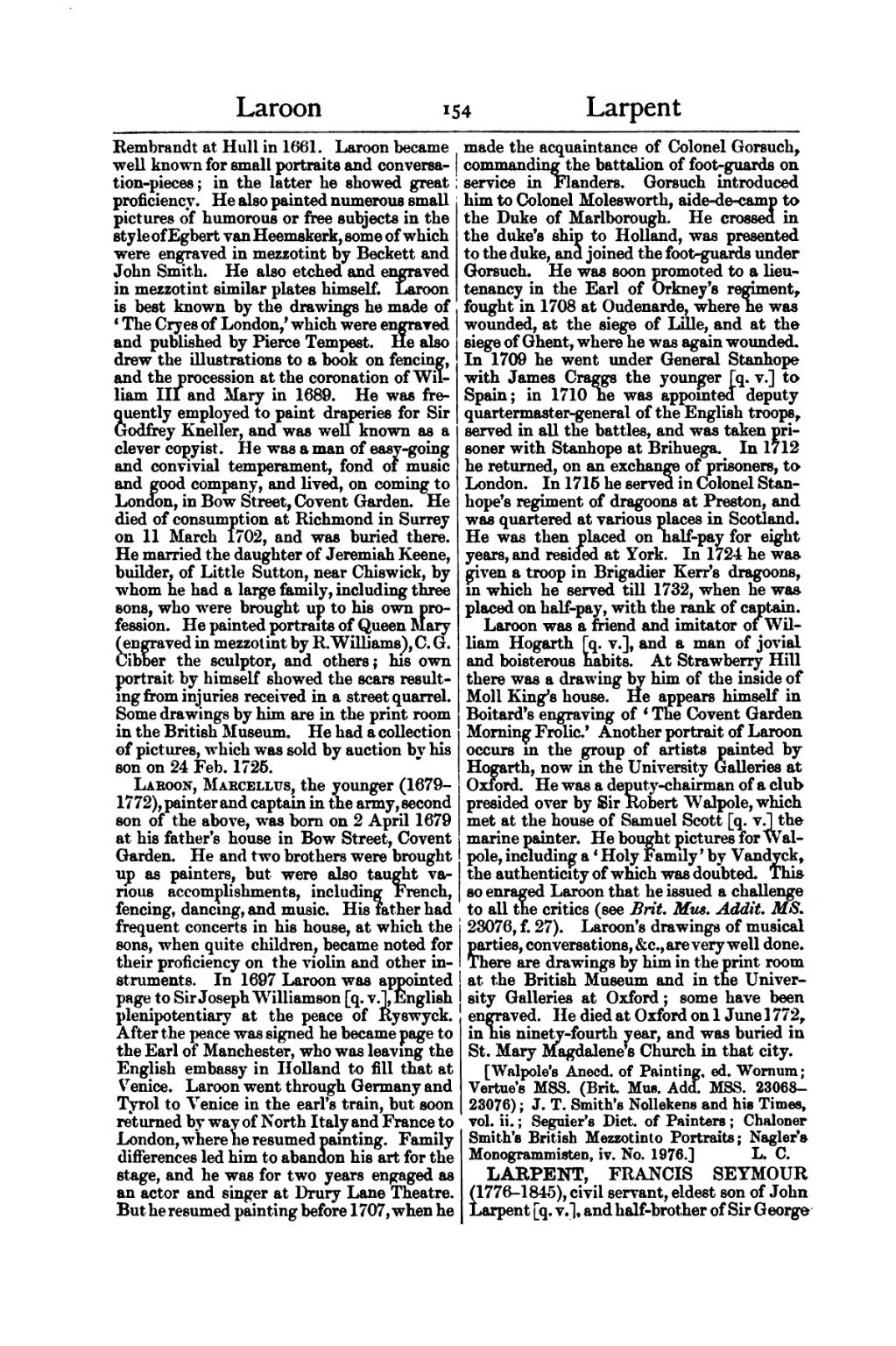Rembrandt at Hull in 1661. Laroon became well known for small portraits and conversation-pieces; in the latter he showed great proficiency. He also painted numerous small pictures of humorous or free subjects in the style of Egbert van Heemskerk, some of which were engraved in mezzotint by Beckett and John Smith. He also etched and engraved in mezzotint similar plates himself. Laroon is best known by the drawings he made of 'The Cryes of London,' which were engraved and published by Pierce Tempest. He also drew the illustrations to a book on fencing, and the procession at the coronation of William III and Mary in 1689. He was frequently employed to paint draperies for Sir Godfrey Kneller, and was well known as a clever copyist. He was a man of easy-going and convivial temperament, fond of music and good company, and lived, on coming to London, in Bow Street, Covent Garden. He died of consumption at Richmond in Surrey on 11 March 1702, and was buried there. He married the daughter of Jeremiah Keene, builder, of Little Sutton, near Chiswick, by whom he had a large family, including three sons, who were brought up to his own profession. He painted portraits of Queen Mary (engraved in mezzotint by R. Williams), C. G. Cibber the sculptor, and others; his own portrait by himself showed the scars resulting from injuries received in a street quarrel. Some drawings by him are in the print room in the British Museum. He had a collection of pictures, which was sold by auction by his son on 24 Feb. 1725.
Laroon, Marcellus, the younger (1679–1772), painter and captain in the army, second son of the above, was born on 2 April 1679 at his father's house in Bow Street, Covent Garden. He and two brothers were brought up as painters, but were also taught various accomplishments, including French, fencing, dancing, and music. His father had frequent concerts in his house, at which the sons, when quite children, became noted for their proficiency on the violin and other instruments. In 1697 Laroon was appointed page to Sir Joseph Williamson [q. v.], English plenipotentiary at the peace of Ryswyck. After the peace was signed he became page to the Earl of Manchester, who was leaving the English embassy in Holland to fill that at Venice. Laroon went through Germany and Tyrol to Venice in the earl's train, but soon returned by way of North Italy and France to London, where he resumed painting. Family differences led him to abandon his art for the stage, and he was for two years engaged as an actor and singer at Drury Lane Theatre. But he resumed painting before 1707, when he made the acquaintance of Colonel Gorsuch, commanding the battalion of foot-guards on service in Flanders. Gorsuch introduced him to Colonel Molesworth, aide-de-camp to the Duke of Marlborough. He crossed in the duke's ship to Holland, was presented to the duke, and joined the foot-guards under Gorsuch. He was soon promoted to a lieutenancy in the Earl of Orkney's regiment, fought in 1708 at Oudenarde, where he was wounded, at the siege of Lille, and at the siege of Ghent, where he was again wounded. In 1709 he went under General Stanhope with James Craggs the younger [q. v.] to Spain; in 1710 he was appointed deputy quartermaster-general of the English troops, served in all the battles, and was taken prisoner with Stanhope at Brihuega. In 1712 he returned, on an exchange of prisoners, to London. In 1715 he served in Colonel Stanhope's regiment of dragoons at Preston, and was quartered at various places in Scotland. He was then placed on half-pay for eight years, and resided at York. In 1724 he was given a troop in Brigadier Kerr's dragoons, in which he served till 1732, when he was placed on half-pay, with the rank of captain.
Laroon was a friend and imitator of William Hogarth (1697–1764) [q. v.], and a man of jovial and boisterous habits. At Strawberry Hill there was a drawing by him of the inside of Moll King's house. He appears himself in Boitard's engraving of 'The Covent Garden Morning Frolic.' Another portrait of Laroon occurs in the group of artists painted by Hogarth, now in the University Galleries at Oxford. He was a deputy-chairman of a club presided over by Sir Robert Walpole, which met at the house of Samuel Scott [q. v.] the marine painter. He bought pictures for Walpole, including a 'Holy Family' by Vandyck, the authenticity of which was doubted. This so enraged Laroon that he issued a challenge to all the critics (see Brit. Mus. Addit. MS. 23076, f. 27). Laroon's drawings of musical parties, conversations, &c., are very well done. There are drawings by him in the print room at the British Museum and in the University Galleries at Oxford; some have been engraved. He died at Oxford on 1 June 1772, in his ninety-fourth year, and was buried in St. Mary Magdalene's Church in that city.
[Walpole's Anecd. of Painting, ed. Wornum; Vertue's MSS. (Brit. Mus. Add. MSS. 23068–23076); J. T. Smith's Nollekens and his Times, vol. ii.; Seguier's Dict. of Painters; Chaloner Smith's British Mezzotinto Portraits; Nagler's Monogrammisten, iv. No. 1976.]
LARPENT, FRANCIS SEYMOUR (1776–1845), civil servant, eldest son of John Larpent [q. v.], and half-brother of Sir George
